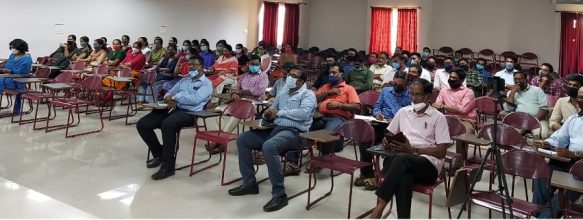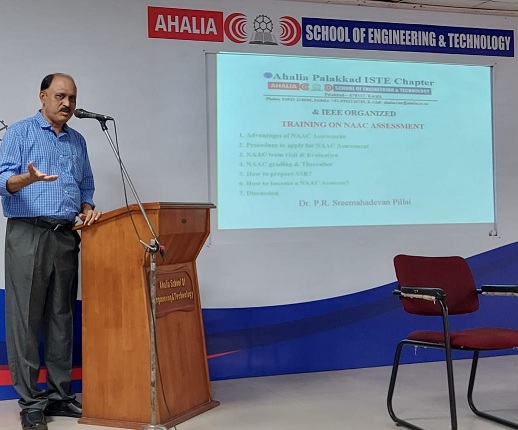A Three-day training Program on NAAC assessment process by Ahalia School of Engineering and technology, jointly associated with ISTE and IEEE was conducted on 9th , 12th and 13th April, at the seminar hall (2-4 p.m.). The training aimed at educating teaching professionals and administrative officials to understand the need of the accreditation process and its benefits. This also helped in analyzing various steps to be carried out in the NAAC process and a brief explanation about the different involved criteria.
Day 1
Session 1: Dr. P. R. Sreemahadevan Pillai – How to become a NAAC assesser? NAAC grading & thereafter Discussions & Clarification of Doubts
Our Principal, Dr. P.R. Sreemahadevan Pillai inaugurated the day 1 session with a discussion on key points of NAAC accreditation process. His words enlightened at many instances, where the requirement of NAAC for affiliated colleges was emphasized. He explained that the NAAC accreditation helps stakeholders in assessing the quality and ranking of the institution. He shared his previous experience as NAAC peer team and the general pattern of valuation. The Principal encouraged to strive for a higher ranking in NAAC, so that the institution can apply for autonomous status. Different grading and points were discussed as given in NAAC Manual. The schedule of the visit, details on SSR and revised accreditation framework were elaborated. The principal suggested that the team members from NAAC will assess as a fact-finding team and not a false finding team. He described about the parameters involved before and after Assessment& Accreditation. Brief details were covered on IIQA, SSR, Data validation & verification, Prequalification, Peer team visit and assessment outcome. In addition, discussion on key points of SSR such as metrics, Rubrics, SSR submission readiness, upload of relevant documents, selection of non-applicable metrics,referring to the standard operating procedure was also carried out. He also indicated preparing feedback form after every session. He concluded the discussion suggesting all the files has to be saved inan external hard disc on a mandatory basis and with the proper naming format so that it can be extracted easily for future purposes.
Session 2: Dr. Murugananth- Criteria 1- Curricular Aspects
Second talk was conducted by Dr. Murugananth, H.O.D. of EEE dept. and he mainly discussedthe first criteria involved in NAAC. He explained that the backbone of NAAC is SSR and the need for ample time in preparing data and proper execution of SSR was educated among the faculty.Core values of NAAC were detailed such as contribution to national development, Inculcating value system among students, fostering global competencies, promoting technology usage and quest for excellence. Distribution of metrics and key indicators across criteria, in-depth knowledge on criteria 1 and their key indicators were also projected throughout the talk.
Session 3: Dr. Gunasekaran- Criteria 4 – Infrastructure & Learning Resources
Dr. Gunasekaran, H.O.D. of C.S.E. Dept., presented about the Criteria 4 and it dealt with Infrastructure and learning resources. Various key indicators were detailed in which the need for library resources and enhancement in ICT infrastructure was explained. He listed out various quantitative and qualitative metrics of Criteria 4. He also covered the topics on filling templates for evaluating maintenance of campus and IT infrastructure, library and physical facilities under this criteria.
Day 2
Session 1: Prof. D. Prakash –Criteria 2- Teaching, learning and evaluation.
Prof. D. Prakash, H.O.D. of M.E. Dept., delivered a lecture on Criteria 2 in which assessment was made on teaching, learning and evaluation. The distribution of Metrics and key indicators across criteria 2 was elaborated. Enhanced training on the collection of data required for last 5 years, its tabulation and evaluation was also conducted. He also detailed the responses to key indicators such as student centric methods, ICT enables tools, mechanism of internal assessment, student satisfaction survey,assessment of various outcomes etc. He concluded the discussion by showing an illustrative example of CO and PO attainment calculation by differentiating direct and indirect assessment.
Session 2: Dr. BinoyBalan- Criteria 5- Student Support & Progression
Dr. BinoyBalan, H.O.D. of S&H Dept., explainedCriteria 5 and its various key aspects to be considered in the evaluation process. Role and responsibilities of student support services was emphasized displaying the collection of data/documents required for validating the institution’s role. He also discussed on the data acquisition related to scholarship details of students, skill & capability enhancement of students, mechanism of student redressal, activities of placement, student activities and awards, the role of alumni activities etc.
Sesssion 3: Dr. Krishna Kumar Kishor – Criteria 3 –Research Innovation & Extension
The third session was delivered by Dr. Krishna Kumar Kishor, Vice Principal and he detailed the criteria 3. Key indicators and metrics required Research innovation and extension activities were elaborated. He explained about the filling of data templates in research mobilization, research publications and awards of faculties, extension activities, collaboration etc. He concluded the session by educating faculties for proper filing of data in the website as well as Google platform and encouraged the faculty to work with mutual cooperation in fulfilling the report preparation.
Day 3
Session 1: Dr. Balamurugan V.- Criteria 6 – Governance, Leadership and Management
The first session was engaged by Dr. Balamurugan V., H.O.D. of E.C. Dept., and detailed on the criteria 6 of NAAC. Quantity metrics of key indicators was stipulated. He also projected the vision and mission statement of the institution and explained the importance of understanding the statements in detail. Draft and revisiting vision and mission statements, methods of revision and displaying the statements effectively. He also indicated hierarchy system in the institution has to be followed for the effective and efficient functioning of developmental schemes. He also explained about the type of documents to be collected in different key indicators, the importance of internal and external audits, documentation of IQACand participation in other ranking agencies for quality assurance.
Session 2: Prof. Kripa K.M. – Criteria 7- Institutional values and best practices
Prof. Kripa K. M., H.O.D. of C.E. Dept., delivered the second session on Criteria 7 which covered the area of Institutional values and best practices. She explained about the key feature to project our college as a social entity. Different type of metrics and their rankings involved in criteria 7 was elaborated. She recommended to consolidate the list of documents such asgeotagged photo graphs, different policy documents, certificates of audit reports, policy documents, awards, student attributes reports etc. to fulfill the data collection. The mode of identifying two best practices of the institution and need of exhibiting the institution as an abode of holistic development was also elaborated.
Session 3: Dr. P. R. Sreemahadevan Pillai – How to become a NAAC assesser? NAAC grading & thereafter Discussions & Clarification of Doubts- Extended
The final session was a continued discussion of the day 1 session and the principal extended his general discussion on NAAC proposals. He urged the departments to identify and come up with 10 best practices of the institutionso that further scrutiny can be processed. The need of maintaining a college diary was explained and it should be self-explanatory in all aspects. He also advised propagatingvision and mission so that the message is conveyed well among students, faculties and all the relevant staff of the institution. The concluding session of the training program paved a way for resolving the queries of faculties regarding the online submission and the processes involved in Assessment and Accreditation.










